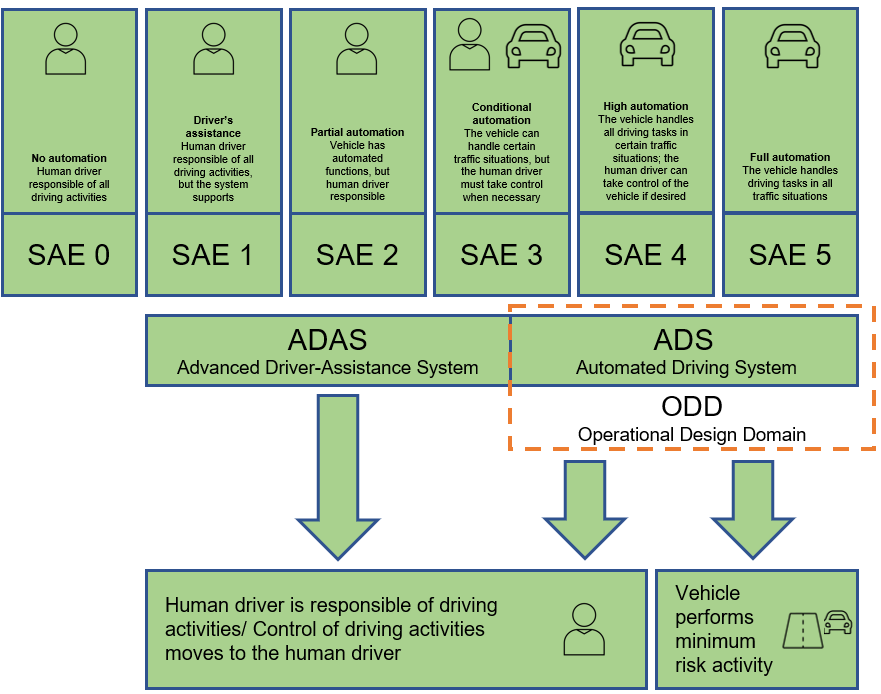General information
Automated mobility refers to vehicles that are capable to operate without human interaction. Depending on a level of automation humans might still be needed in the process, as a role of safety driver (on board) or remote operator (off board). Different levels of automation are commonly described by SAE-levels as presented in the picture below. Important difference is between ADAS, which refers to Advanced Driver-Assistance Systems, and ADS, which refers to Automated Driving Systems. With the lower automation levels (ADAS) human driver is always responsible for the vehicle operation, but with the higher automation levels (ADS), the vehicle itself is responsible for the dynamic driving tasks.
Legislation in Finland currently requires every vehicle to have a human driver, but this driver doesn’t need to be inside the vehicle, therefore making remote operations possible. In practice all the Finnish pilots involving higher levels of automation have started with the safety driver on board, but the aim is to remove safety driver and support on remote operator.

Benefits of automation
The main aim for urban mobility planning is to achieve more sustainable, accessible, and safer transportation system. Automated mobility is a mean to achieve this goal, not a goal itself. In some scenarios automated mobility services could even be harmful for the urban transport, for example by encouraging people to change from public transportation to automated robotaxis. This would increase the vehicle-kilometres driven. Therefore, urban mobility planners need to make sure that the utilization of automated mobility is done in a such way that the negative impacts are minimized.
In the city of Tampere, the benefits of automated mobility are recognized to be part of public transportation system. In this way the costs of public transportation could be reduced and the service level increased. Especially potential application of automated mobility could be the feeder transportation to the tram, and this has been piloted already in Tampere in real traffic environment. In addition, automated mobility has multiple use cases from city logistics to closed area (such as factories) applications and public transportation.
Piloting in Tampere
The city of Tampere has been an active piloting site and partner for the applications of automated mobility. Also, ITS Factory and its members have been playing a vital part for the piloting activities. In Tampere automated mobility is piloted mostly with different shuttle bus use cases. Automated mobility that supports public transportation is in line with the strategic goals of the city and therefore preferred use case.
With these pilots the automated mobility technology has been proven to be capable of operating in designated situations. However, automated mobility is not yet ready for commercial use, but it could already be utilized to solve actual public transportation related issues, such as cost-effectiveness and service-level increase. Also, the feedback from the passengers has been very positive and the citizens of Tampere are ready for the automated mobility.
If you have an idea or a pilot in your mind regarding the automated mobility, you can contact ITS Factory. A test plate certificate is required in order to operate on public streets and this certificate is applied from Finnish Transport and Communications Agency Traficom.
Read more about the automated mobility pilots in Tampere
Digital infrastructure to support automation
Although automated vehicles are capable to operate by relaying the vehicle sensor data, they could benefit from the external information that other vehicles, infrastructure, or traffic management centers can offer. Automated connected vehicles can expand their digital horizon and be better prepared for surprising traffic or weather situations beyond their sensor range. This enhances the customer experience and improves safety of the passengers.